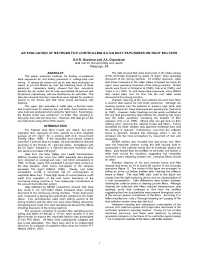Mining Publication: An Evaluation of Methods for Controlling Silica Dust Exposures on Roof Bolters
Original creation date: February 2002
This paper examines methods for limiting occupational silica exposures for roof bolting personnel in underground coal mining. A canopy air curtain and an air tube were evaluated as means to provide filtered air over the breathing zone of these personnel. Laboratory testing showed that dust reductions beneath the air curtain and air tube approached 60 percent and 40 percent, respectively, with low interference air velocities. The data also showed that dust reductions were highest for positions closest to the device and that these levels decreased with distance. This paper also evaluates a metal rake, a flexible insert, and a rigid insert for cleaning the roof bolter dust collector box. Less dust was produced when using the rigid insert. Surprisingly, the flexible insert was sometimes no better than scraping or raking the dust onto the mine floor. However, little dust got on the coveralls when using either of the inserts.
Authors: GV Goodman, JA Organiscak
Conference Paper - February 2002
NIOSHTIC2 Number: 20023177
2002 SME Annual Meeting, Feb 25-27, Phoenix, Arizona, preprint 02-163. Littleton, CO: Society for Mining, Metallurgy, and Exploration, Inc., 2002 Feb; :1-5
See Also
- Best Practices for Dust Control in Coal Mining
- Best Practices for Dust Control in Metal/Nonmetal Mining
- Control of Respirable Dust
- Improving Silica Dust Control Through Targeted Research
- Improving the Performance of Fan-Powered Dust Collectors in Stone-Cutting Applications
- Laboratory Evaluation of a Canopy Air Curtain for Controlling Occupational Exposures of Roof Bolters
- NIOSH Hazard Controls 27 - New Shroud Design Controls Silica Dust from Surface Mine and Construction Blast Hole Drills
- Silica Dust Sources in Underground Limestone Mines
- Silica Dust Sources in Underground Metal/Nonmetal Mines - Two Case Studies
- Silica...It's Not Just Dust
- Page last reviewed: 9/21/2012
- Page last updated: 9/21/2012
- Content source: National Institute for Occupational Safety and Health, Mining Program


 ShareCompartir
ShareCompartir
